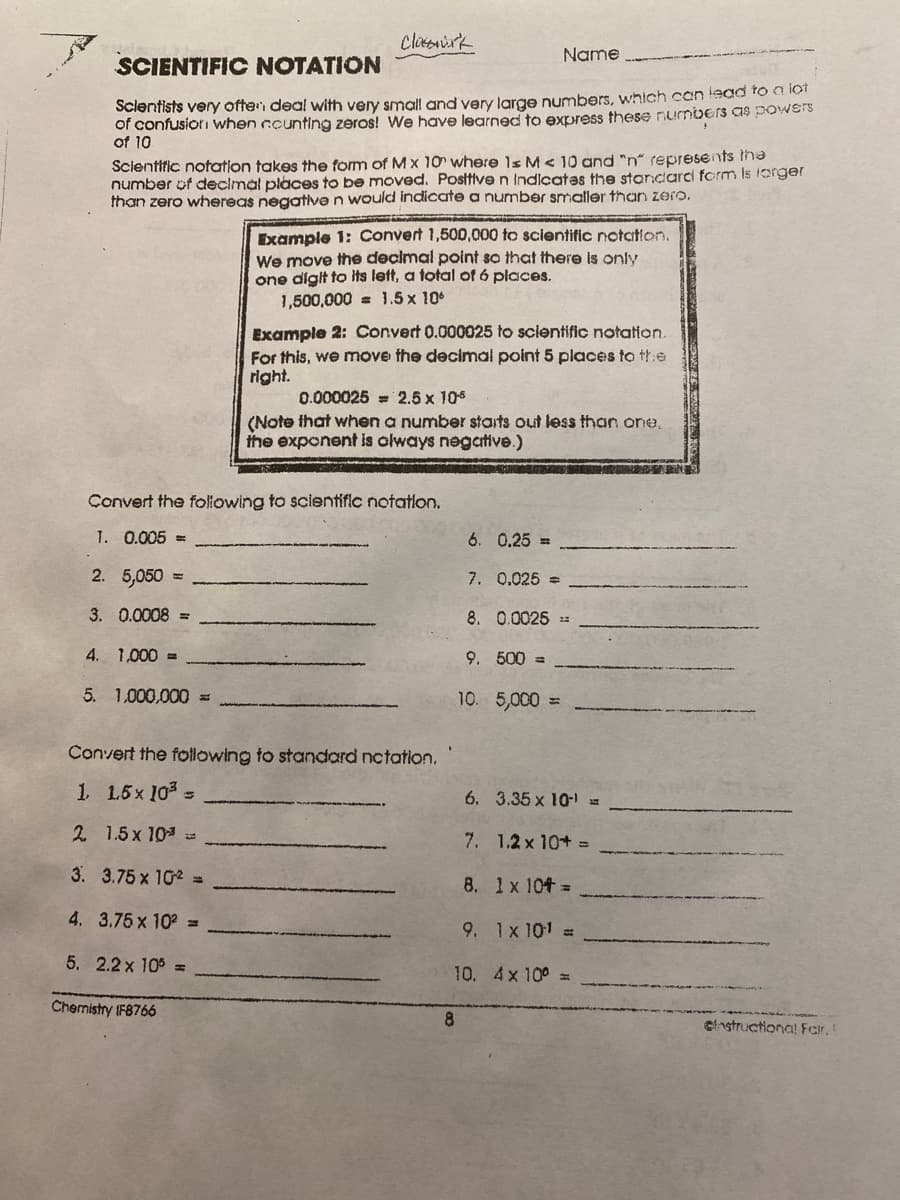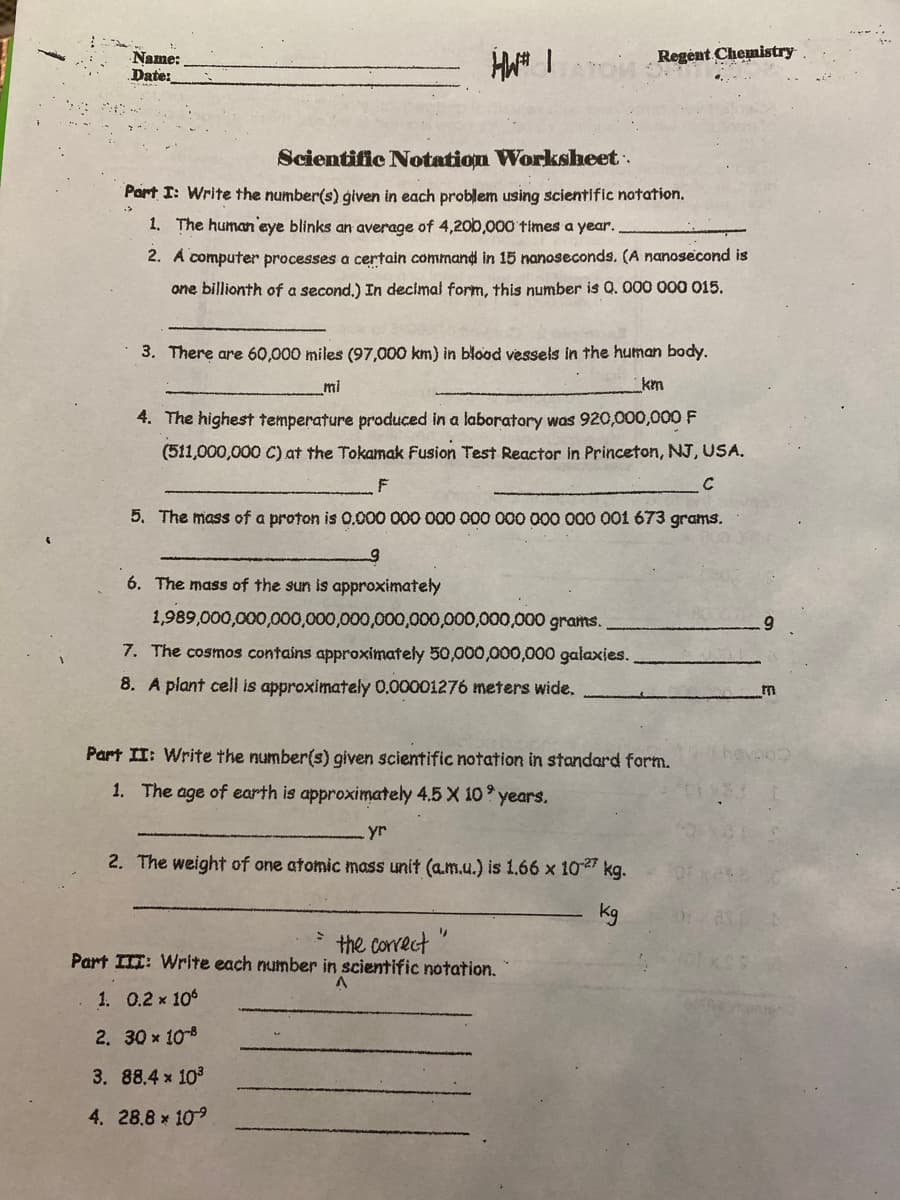Chemistry: Principles and Reactions
8th Edition
ISBN:9781305079373
Author:William L. Masterton, Cecile N. Hurley
Publisher:William L. Masterton, Cecile N. Hurley
Chapter1: Matter And Measurements
Section: Chapter Questions
Problem 38QAP: A gasoline station in Manila, Philippines, charges 38.46 pesos per liter of unleaded gasoline at a...
Related questions
Question
Please solve this sheet

Transcribed Image Text:clatsnirk
Name
SCIENTIFIC NOTATION
Sclentists very often deal with very small and very large numbers, which can laad to a ior
of confusiori when ccunting zeros! We have learned to express these numbers s powsis
of 10
Scientific notation takes the form of M x 10 where 1s M< 10 and "n" represents tha
number of decimal places to be moved. Posttive n Indicatas the stancard form Is 1orger
than zero whereas negative n would indicate a number smatler than zero.
Example 1: Convert 1,500,000 to scientific notation.
We move the decimal point so that there is only
one digit to Its lett, a total of 6 places.
1,500,000 = 1.5 x 10
Example 2: Convert 0.000025 to scientific notation.
For this, we move the decimal point 5 places to thhe
right.
0.000025 = 2.5 x 10s
(Note that when a number starts out less than one.
the exponent is olways negative.)
Convert the foliowing to scientific notatlon.
1. 0.005 =
6. 0,25 =
2. 5,050 =
7. 0.025 =
3. 0.0008 =
8. 0.0025 =
4. 1,000 =
9. 500 =
5. 1.000,000 =
10. 5,000 3D
Convert the following to standard nctation.
1 1.5x 10 =
6. 3.35 x 10-
2 1.5x 10 s
7. 1.2 x 10+ =
3. 3.75 x 102 =
8. 1x 104 =
4. 3.75x 102 =
9. 1x101 =
5. 2.2 x 10 =
10. 4x 10°
Chemistry (F8766
8.
chstructiona! Far.!

Transcribed Image Text:Name:
Date:
Regent Chemistry
Scientific Notation Worksheet.
Part I: Write the number(s) given in each problem using scientific notation.
1. The human eye blinks an average of 4,200,000 times a year.
2. A computer processes a certain command in 15 nanoseconds. (A nanosecond is
one billionth of a second,) In decimal form, this number is Q. 000 000 015.
3. There are 60,000 miles (97,000 km) in blood vessels in the human body.
_ml
km
4. The highest temperature produced in a laboratory was 920,000,000 F
(511,000,000 C) at the Tokamak Fusion Test Reactor in Princeton, NJ, USA.
C
5. The mass of a proton is 0.000 000 000 000 000 000 000 001 673 grams.
6. The mass of the sun is approximately
1,989,000,000,000,000,000,000,000,000,000,000 grams.
7. The cosmos contains approximately 50,000,000,000 galaxies.
8. A plant cell is approximately 0,00001276 meters wide.
Part II: Write the number(s) given scientific notation in standard form.
1. The age of earth is approximately 4.5 X 10 years.
yr
2. The weight of one atomic mass unit (a.m.u.) is 1.66 x 10 kg.
kg
the correct
Part III: Write each number in scientific notation.
1. 0.2 x 106
2. 30 x 108
3. 88.4 x 10
4. 28.8 x 109
Expert Solution
This question has been solved!
Explore an expertly crafted, step-by-step solution for a thorough understanding of key concepts.
Step by step
Solved in 2 steps with 2 images

Recommended textbooks for you

Chemistry: Principles and Reactions
Chemistry
ISBN:
9781305079373
Author:
William L. Masterton, Cecile N. Hurley
Publisher:
Cengage Learning

Introductory Chemistry: A Foundation
Chemistry
ISBN:
9781337399425
Author:
Steven S. Zumdahl, Donald J. DeCoste
Publisher:
Cengage Learning


Chemistry: Principles and Reactions
Chemistry
ISBN:
9781305079373
Author:
William L. Masterton, Cecile N. Hurley
Publisher:
Cengage Learning

Introductory Chemistry: A Foundation
Chemistry
ISBN:
9781337399425
Author:
Steven S. Zumdahl, Donald J. DeCoste
Publisher:
Cengage Learning


World of Chemistry, 3rd edition
Chemistry
ISBN:
9781133109655
Author:
Steven S. Zumdahl, Susan L. Zumdahl, Donald J. DeCoste
Publisher:
Brooks / Cole / Cengage Learning

Chemistry by OpenStax (2015-05-04)
Chemistry
ISBN:
9781938168390
Author:
Klaus Theopold, Richard H Langley, Paul Flowers, William R. Robinson, Mark Blaser
Publisher:
OpenStax